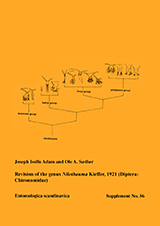Entomologica Scandinavica Supplement 56
now changed to Insect Systematics and Evolution Supplement
ESS 56.
Adam, I. J. & Saether, O. A. Revision of the genus Nilothauma Kieffer, 1921 (Diptera Chironomidae). 1999. 107 pp. SEK 200.
Abstract:
A revised generic diagnosis of the genus Nilothauma Kieffer, 1921a, is given. Toyayusurika Sasa, Suzuki et Sakai, 1998, is a junior synonym of Nilothauma, and T. simantofea Sasa, Suzuki et Sakai, a junior synonym of N. hibaratertia Sasa. N. jintuprimum (Sasa) is shown to be a junior synonym of N. japonicum Niitsuma.
Sixteen new species are described; N. sasai sp. n. from Japan in both sexes and all stages, N. verrucum sp. n. from Canada as 7 and 6 imagines and tentatively associated larva, N. adunatum sp. n. from Australia as 7 imago based on a mature pupa, N. fuscina sp. n., N. duminola sp. n., N. insolitum sp. n., N. flabellatum sp. n., and N. ankasense sp. n. from Ghana, N. burmeisteri sp. n. from Ghana and D. R. Congo, N. mergae sp. n. from Thailand, N. infissum sp. n. from Australia, N. acre sp. n. from China, N. latocaudatum sp. n. from Zimbabwe, N. anderseni sp. n. from Tanzania, N. harrisoni sp. n. from South Africa, and N. kakumense sp. n. from Ghana as 7 imagines. N. japonicum Niitsuma and N. brayi (Goetghebuer) are described or redescribed in both sexes and all stages; N. bicorne (Townes) as 7 imagines, pupae and larvae; N. pictipenne Kieffer as 7 and 6 imagines; N. babiyi (Rempel) and N. mirabile (Townes) as 7 imagines and tentatively associated larvae; N. hibaratertium Sasa, N. nojirimaculatum Sasa and N. hibaraquartum Sasa as 7 imagines. An unassociated pupa from Australia is described. — Keys to 7 imagines, known 6 imagines, known pupae and larvae of Nilothauma are given and the phylogenetic relationships of the Nilothauma group of genera (Nilothauma, Neelamia Soponis, 1986, and Paranilothauma Soponis, 1986) as well as species of Nilothauma discussed.
The genus Paratendipes Kieffer apparently forms the sister group of a group consisting of the genera Paranilothauma, Neelamia and Nilothauma. Within Nilothauma, 4 species groups are recognised with the duminola-group forming the sister group of the remaining groups. The babiyi-group apparently forms the sister group of the brayi and the pictipenne-groups combined. — Paratendipes is cosmopolitan. The Neotropical group of genera (Neelamia and Paranilothauma), probably together with some basal species of Nilothauma, appear to have split off very early with the fragmentation of Pangaea. The species of Nilothauma treated here are of Megagaeic lineages and are confined to the Holarctic, Sino-Indian, Afrotropical and Australian zoogeographical regions for freshwater fauna.
The duminola-group is made up of 2 Afrotropical species. The sister species N. duminola and N. fuscina are exclusively Afrotropical and from the same locality in Ghana. The babiyi-group is made up of 2 Nearctic species which, however, probably originated in the original Gondwanian part of North America. The brayi-group may be divisible in 2 groups. One group includes the Afrotropical N. burmeisteri and N. ankasense, the East Asian N. japonicum and N. mergae and the Nearctic N. bicorne, while in the other group two Australian species (N. adunatum and N. infissum) form the sister group of one European (N. brayi), 2 East Asian (N. sasai and N. acre), one East Asian and probably European (N. hibaratertium), and one Nearctic species (N. mirabile). The pictipenne-group is made up of 2 species (N. nojirimaculatum Sasa and N. hibaraquartum Sasa) from the Sino-Indian region and 7 species (N. insolitum, N. harrisoni, N. anderseni, N. latocaudatum, N. pictipenne, N. flabellatum and N. kakumense) from the Afrotropical Region.
— The phyletic interrelationship of the Nilothauma group of genera combined with the corresponding area cladogram, BPA analysis and estimations of ancestral areas suggests the early splitting of their common ancestor into a Neotropical group (Neelamia, Paranilothauma and perhaps the babiyi-group) and a Megagaeic lineage. The Megagaeic lineage group made up of most Nilothauma species shows a warm/eurythermic vicariant Gondwanan pattern with multiple sister group relationships between the East Asia subregion and the Afrotropical region.
The linkage with the Australian region could be due to the same pattern or, more likely, to recent dispersals from Asia, i.e. post-Miocene contacts. The East Asia Ð North America linkage likely is of post-Miocene origin. The European species, N. brayi and N. ?hibaratertium, most likely is a result of dispersal from East Asia. — The distributions and ecologies of the different species of the genus are outlined.

